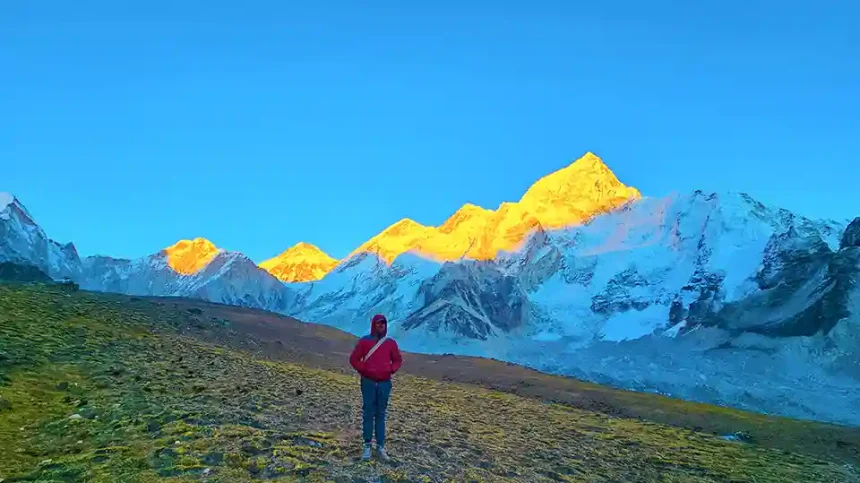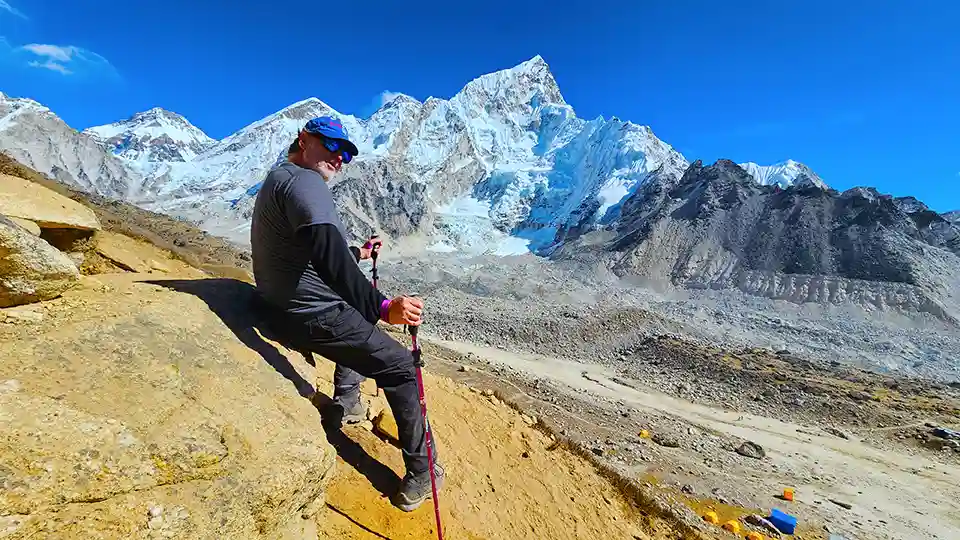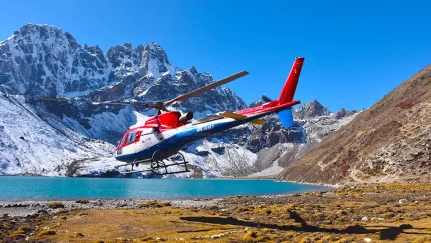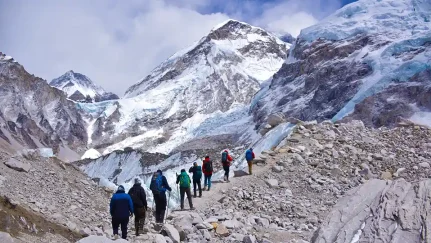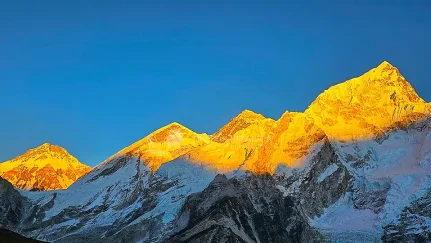Sagarmatha National Park is one of the most renowned national parks in the world with the presence of glaciers, deep valleys, and high mountains including the world’s tallest mountain, Mount Everest (Sagarmatha). Being home to Mount Everest and a sanctuary for diverse flora and fauna, Sagarmatha National Park is a paradise for trekkers, nature enthusiasts, and adventure seekers.
With this short introduction, we will now further delve into the various aspects of Sagarmatha National Park. All of this information about the Sagarmathe National Park will serve as a guide to the journey towards this park. So without wasting any time, let’s get started-
Where is Sagarmatha Located?
Mount Everest, also known as Sagarmatha in Nepali, is situated in the Mahalangur region of the Himalayas in northeastern Nepal. The translation of “Sagarmatha” is “Forehead in the Sky,” which is an appropriate moniker for the tallest peak in the world that rises to an incredible 8,848.86 meters (29,031.7 ft) above sea level.
- Trekker posing in front of Sagarmatha
Where is Sagarmatha National Park Located?
Sagarmatha National Park includes the area surrounding Mount Everest as well as several other famous peaks, including Lhotse, Nuptse, and Cho Oyu. Situated in the Solu-Khumbu District of the Sagarmatha Zone, the park was established in 1976. Located between 27° 45′ and 28° 07′ N in latitude and 86° 28′ to 87° 07′ E in longitudinal range, this region is a part of the eastern Himalayas.
Area of Sagarmatha National Park
The total area of Sagarmatha National Park is roughly 1,148 square kilometers (443 square miles). Moreover, this vast region covers a broad range of heights. This National park covers the area from the highest point of Mount Everest to 2,845 meters (9,334 feet) at Jorsalle. Hence, due to its varied topography, people have to live in unique and challenging environments.
- Trekkers getting ready to head for Sagarmatha National Park
Kathmandu to Sagarmatha National Park
The journey to Sagarmatha National Park from Nepal’s capital city of Kathmandu is an adventure unto itself. Usually, the trip takes a plane from Kathmandu (1400 meters) to Lukla, a tiny town at 2,860 meters (9,383 feet) above sea level. Particularly in Lukla, travelers will arrive at Tenzing-Hillary Airport, which is one of the most thrilling places to land in the world because of its small runway and scenic setting.
Then from Lukla, trekkers will leave Lukla and go through beautiful villages, suspension bridges, and green forests for several days to reach Monjo, the park’s entry point. Then finally, you will go from Monjo to Namche Bazaar, which is home to the headquarters of Sagarmatha National Park. Usually, it takes two days to reach Namche Bazaar, depending on the trekkers’ acclimatization needs and pace.
How to Reach Sagarmatha National Park?
There are two main ways to reach Sagarmatha National Park:
By Air: The most common and efficient route is to fly domestically from Kathmandu to Lukla. The flight takes about 30-40 minutes. Then from Lukla, trekkers can begin their trek towards the park, passing through Phakding, Monjo, and Namche Bazaar.
By Road and Trek: For those seeking a more extended adventure, it is possible to travel by road from Kathmandu to Jiri or Salleri and then trek to Lukla. This route to Sagarmatha National Park takes longer, but it offers a more gradual acclimatization process and an opportunity to explore the lesser-visited parts of the Solu-Khumbu region.
Sagarmatha National Park Animals
With a wide range of species that have adapted to live at high altitudes, Sagarmatha National Park is a nature lover’s paradise. The following are a few of the park’s significant animals:
Snow Leopard: Seeing this rare and threatened big cat is one of the park’s most desirable sights. It lives mostly at higher altitudes and is renowned for its amazing camouflage.
Himalayan Tahr: It’s common to see these massive animals feeding on the steep hillsides. They are strong-limbed and well-suited to the rough terrain since they have thick coats on their body.
Red Panda: Though rarely seen due to its cautious character, the red panda lives in forests in altitudes ranging from (2400 – 3900) meters. Travelers can immediately identify them by their reddish-brown fur and bushy tail.
Musk Deer: This solitary deer is well known for its large, fang-like tusks. They are often found in the forested areas of the park.
Himalayan Monal: This vibrantly colored bird known as the Impeyan pheasant, is the national bird of Nepal. It can be seen in the forests and meadows of the alpine regions.
5 Facts About Sagarmatha National Park
UNESCO World Heritage Site: Sagarmatha National Park is a designated UNESCO World Heritage Site, thanks to its unique natural beauty and ecological significance.
Sherpa Culture: The Sherpa people, who are well-known for their expertise in mountaineering and their significant cultural legacy call home to this park. Especially, the park’s headquarters and cultural center are located in the Famous Sherpa town, Namche Bazaar.
Varied Climate Zones: The park comprises multiple climate zones, ranging from lower temperate forests to arctic temperatures close to the peaks. Therefore, a vast variety of flora and wildlife are supported by these diverse zones.
Glacial Systems: One of the biggest glaciers in the world, Khumbu Glacier is found in the park. This glacier is also a significant source of the Dudh Kosi River.
Trekking Routes: The most well-known trekking routes in the world, such as the Gokyo Lakes and Everest Base Camp treks must be done by passing through the routes of this park. Thus, there is no question that these routes give amazing views of the Himalayan peaks and valleys.
When was Sagarmatha National Park enlisted in the World Heritage List?
Sagarmatha National Park was enlisted as a UNESCO World Heritage Site in 1979. UNESCO acknowledged the region’s pure natural heritage and the unmatched elegance of its high mountains and glaciers and designated the park as a World Heritage Site.
Sagarmatha National Park Entry Fee
As of the latest updates, the entry fee for Sagarmatha National Park is as follows:
Foreign Nationals: NPR 3,000 (approximately USD 25) per person.
SAARC Nationals: NPR 1,500 (approximately USD 12.50) per person.
Nepali Citizens: NPR 100 per person.
These fees are not collected for private use, it is used for the conservation and management of the park. Doing it ensures that its natural beauty and biodiversity are preserved for future generations.
Sagarmatha National Park Temperature
The altitude and season have a major impact on Sagarmatha National Park’s temperature. In the lower regions, temperatures can range from 10°C to 20°C (50°F to 68°F) during the days, while in the nighttime the temperature will be much colder. Moreover, at higher altitudes, the temperatures can drop to -20°C (-4°F) or lower, especially during the winter months (December to February).
Especially, spring (March to May) and autumn (September to November) are often the best times to visit the park, with moderate temperatures and clear skies. During these seasons, daytime temperatures in the higher altitudes range from 7°C to 15°C in spring, whereas in autumn the temperature ranges from 4°C to 16°C, making it ideal for trekking.
Importance of Sagarmatha National Park
Sagarmatha National Park is highly valuable for several reasons. Here are some of its importance-
Ecological Significance: Numerous species of flora and wildlife, many of which are native or endangered, are supported by the park’s various environments. Therefore, through conservation efforts, these species are protected and ecological balance is preserved.
Cultural Heritage: The park is an asset to culture as well as a wonder of nature. It is the home of the Sherpa people, whose customs, holidays, and way of life are essential to the identity of this region. Through homestays, local marketplaces, and monasteries, tourists can get a taste of Sherpa culture.
Adventure Tourism: Trekkers and mountaineers from all over the world go to Sagarmatha National Park. Many people have the desire to travel to Everest Base Camp since it offers trekkers magnificent views and a sense of accomplishment.
Scientific Research: For scientists researching glaciology, climate change, and high-altitude ecosystems, the park acts as an ecological facility. The research being done here advances our knowledge of these important topics.
Global Icon: The park’s main attraction, Mount Everest, represents human ambition, tenacity, and the spirit of adventure. Mainly, it encourages people all throughout the world to reach their goals and exceed their comfort zones.
Things to Do in Sagarmatha National Park
Travelers of all experience levels can enjoy various adventures at Sagarmatha National Park. Here are the following are some of the best things you can do inside the park:
Trekking: Trekking is the most well-liked activity in Sagarmatha National Park. The most well-known route to Everest Base Camp is the activity that comes across the Sagarmatha National Park, which provides amazing views of Mount Everest and the surrounding peaks. The Three Passes and Gokyo Lakes treks are two other noteworthy treks that pass through the Sagarmatha National Park.
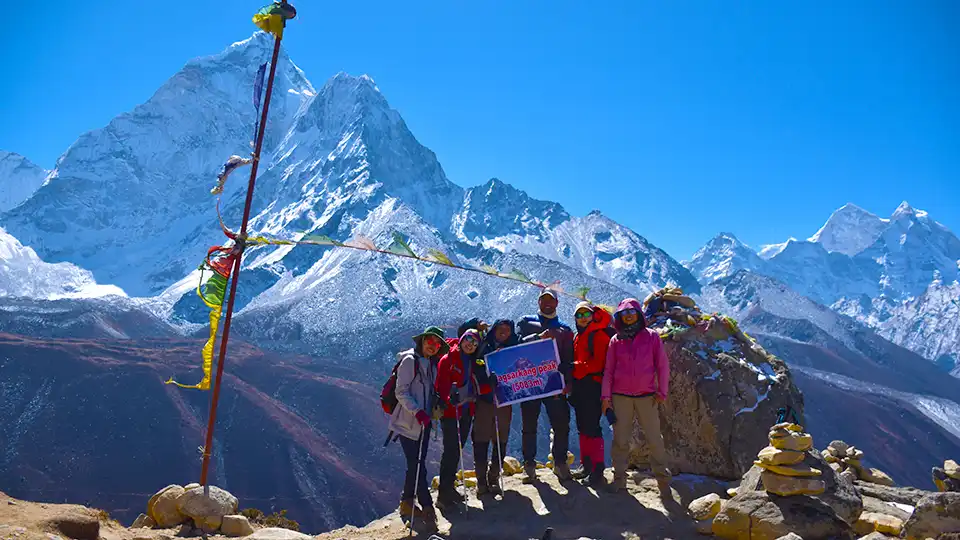 trekkers Taking Photo inside Sagarmatha National Park in DingbocheInfotrekkers Taking Photo inside Sagarmatha National Park in Dingboche
trekkers Taking Photo inside Sagarmatha National Park in DingbocheInfotrekkers Taking Photo inside Sagarmatha National Park in Dingboche- trekkers Taking Photo inside Sagarmatha National Park in Dingboche
Mountaineering: Some of the world’s most difficult and rewarding mountaineering expeditions are accessible to skilled climbers through the Sagarmatha National Park. Some of the peaks that draw Mountaineers from all around the world are Ama Dablam, Lhotse, and Mount Everest.
Wildlife Watching: The park offers many chances to see wildlife thanks to its different ecosystems. Adventurers will have the opportunity to witness Himalayan tahrs, red pandas, snow leopards, and a diversity of bird species.
Cultural Tours: Explore monasteries like Tengboche Monastery and engage with the locals in villages like Namche Bazaar and Khumjung to learn more about the rich cultural legacy of the Sherpa people.
Photography: Sagarmatha National Park is a photographer’s dream come true because of its beautiful surroundings, unique wildlife, and lively culture. Here the adventurers will always get to capture the Sherpa people’s everyday lives as well as their beautiful peaks and peaceful valleys.
Museum Visits: To find out more about the natural surroundings and cultural history of the area, travelers can go to the Sagarmatha National Park Museum in Namche Bazaar and other many museums inside the region.
Conclusion
Hence, Sagarmatha National Park is the area that doesn’t only represent Everest, it represents the whole natural ecosystem along with the unique cultures and landmarks of the people living inside it. With the mixture of the unique high mountains, diverse wildlife, and amazing culture, we have to say that this national park is like no other. So, whether you are a climber, trekker, nature lover, researcher, or cultural explorer, Sagarmatha National Park has it all to mesmerize you. It will make you appreciate the beauty of the natural world and provide proof of the human spirit’s fortitude.
Furthermore, you need to get ready and prepare yourselves to go on an adventure at Sagarmatha National Park. To get there, you’ll also have to manage a variety of processes. Therefore by helping such travelers and adventurers with such things, we make their job easy.
So, if you have any questions or concerns about your visit to Sagarmatha National Park or any other National Park you can contact us by phone at +977-9841965533 or via landline at +977-14700252. Alternatively, you can also contact us through email at info@missionhimalayatreks.com or by sending a message on our WhatsApp. Happy Travels!

